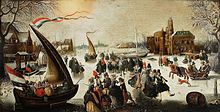I'd make a great passenger! :o)
Ice Boats
Info from Wikipedia:
Iceboats, 17th century
One unique type of ice boat has its history in wide, stubby, scow-like vessels used in the 1800s, often for transportation across a mixed passage transitioning over sea-ice and open water. Wildly sailed by adjusting main and jib sail trim only, these boats had no rudder. Parallel rails were mounted on the bottom, like multiple sled runners. These early vessels (called an "ice scooter" or "bay scooter") were capable of simultaneously and daringly traversing both open water and jumping onto stretches of ice and were used primarily for winter transportation to and from lighthouses and for ice fishing. In 1869, one of the largest ice yachts ever was built for racing on the frozen Hudson River, called the Icicle. That boat occasionally raced the railroad which ran alongside the Hudson.
The first iceboats were adaptations of regular sailing boats, with a wooden plank fastened cross-wise at the front having a fixed runner at each end, and a steering runner attached to the bottom of the rudder at the stern (back). These early ice sailing vessels led to the development of boats designed strictly for racing on ice. These "stern-steerer" iceboats were generally rigged as sloops, with a jib sail forward of the mast, although the catboat style with a single sail was also used.
The traditional stern-steerer boats were largely replaced by front steering boats in the 1930s, following the development of this style by Walter Beauvois of Williams Bay, Wisconsin in a boat named the Beau Skeeter. This boat led to the "Skeeter" class, and the Skeeter Ice Boat Club formed on Geneva Lake, Wisconsin. The Skeeter class adopted the logo of a mosquito on their sail, and has evolved into a very efficient aerodynamically clean machine. While the large stern-steerers could have up to 600 square feet (56 m2) of sail, the Skeeter class is limited to just 75 square feet (7.0 m2) of sail.
In 1937, The Detroit News sponsored a new home-buildable ice boat design, which became the International DN. In 1968 Dick Slates of Pewaukee, Wisconsin designed and built the Nite with two wooden prototypes. The design was refined and fiberglass production began in 1970.
Icy areas
A DN iceboat on lake Balaton, Hungary
Among avid iceboaters and racers, safety always comes first, including consideration for one's fellow competitor. The sailing and Rights-of-Way rules are written, enforced and are expected to be known and conformed with by everyone who sails. Speeds reached, parallel, crossing and closing, are often very high. Visibility can be limited by changing conditions. Protective sailing apparel, such as a wind-chill-proof suit, helmet, goggles, gloves and spiked shoes are recommended. Safe conditions of sail able ice can change quickly with variations in precipitation, ambient light, temperature and wind. Newcomers to the sport should seek out experienced "hard-water" sailors in order to gain support and advice on safe sailing conduct.



No comments :
Post a Comment